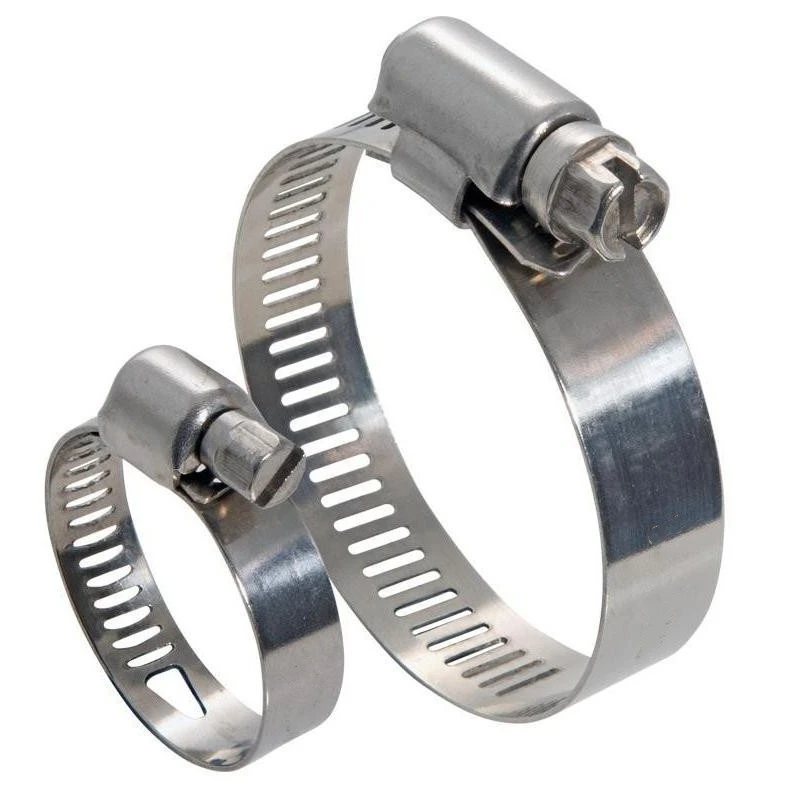Hose Clamp
Hose clamps are essential fastening devices designed to secure hoses onto fittings such as pipes, tubes, or connectors, ensuring a tight, leak-proof seal in a wide range of applications. Manufactured from high-quality materials like stainless steel, galvanized steel, or durable plastic, hose clamps offer excellent corrosion resistance, strength, and longevity.
One of the primary features of hose clamps is their adjustable design, which allows for a precise fit on hoses of varying diameters. Common types include worm gear clamps, spring clamps, and ear clamps, each providing different levels of flexibility and clamping force to suit specific needs. Worm gear clamps, for example, use a screw mechanism to tighten the band, providing strong and secure fastening.
Hose clamps are widely used in automotive, industrial, agricultural, and plumbing sectors for securing fuel lines, coolant hoses, air hoses, and other fluid transfer connections. They ensure that hoses remain firmly attached even under high pressure, vibration, or temperature changes.
These clamps are designed for easy installation and removal using standard tools like screwdrivers or pliers, enabling quick maintenance and replacement. The smooth edges and rounded bands help protect hoses from damage during clamping, preventing cuts or abrasions.
Available in various sizes and materials, hose clamps can accommodate hoses ranging from small diameter tubes to large industrial hoses. Their durability and reliability make them an indispensable accessory for preventing leaks and maintaining system integrity.
In summary, hose clamps provide secure, adjustable, and corrosion-resistant fastening solutions, ensuring reliable hose connections across diverse applications.
What Is the Purpose of a Hose Clamp Ring?
A hose clamp ring is a mechanical device designed to secure a hose onto a fitting such as a pipe, tube, or barb, ensuring a tight and leak-proof connection. Its primary purpose is to prevent the hose from slipping off or leaking when fluids or gases flow under pressure through the hose.
The hose clamp ring works by applying uniform pressure around the circumference of the hose, compressing it firmly against the fitting. This pressure creates a seal that stops fluid from escaping at the connection point. Without a hose clamp ring, hoses can loosen over time due to vibration, temperature changes, or pressure fluctuations, leading to leaks, spills or system failures.
Hose clamp rings are widely used in automotive, plumbing, industrial, and agricultural applications. They help maintain the integrity of fuel lines, coolant systems, air hoses, and water pipes, among others. The clamps are available in various materials, such as stainless steel or galvanized steel, offering excellent corrosion resistance and durability in harsh environments.
Many hose clamp rings feature adjustable designs, such as worm gear mechanisms, allowing users to tighten or loosen the clamp easily for installation or maintenance. This adjustability makes them versatile for hoses of different sizes.
In summary, the purpose of a hose clamp ring is to securely fasten hoses to fittings, ensuring leak-free and reliable connections under pressure, preventing hose detachment, and protecting system performance and safety.
What Are the Three Types of Clamps?
Clamps are essential tools used to hold, secure, or fasten objects tightly together, and there are many types designed for specific applications. Among the various types, three common clamps widely used in industries and everyday applications are hose clamps, C-clamps, and spring clamps.
Hose Clamps:
Hose clamps are used to secure hoses onto fittings like pipes or tubes, preventing leaks and ensuring a tight seal. They come in various designs, such as worm gear clamps, spring clamps, and ear clamps. Worm gear clamps use a screw mechanism to tighten the band around the hose, providing adjustable and strong fastening. Spring clamps use the tension of a coiled spring to apply pressure, making them quick to install and remove. Ear clamps feature a “pinch” design, where the clamp is crimped to tighten permanently.
C-Clamps:
C-clamps, also known as G-clamps, are versatile fastening tools shaped like the letter “C.” They are commonly used in woodworking, metalworking, and construction to hold materials firmly in place during gluing, welding, or cutting. C-clamps have a screw mechanism that allows precise adjustment of clamping pressure.
Spring Clamps:
Spring clamps rely on the tension of a spring to hold objects together. They are lightweight, easy to use, and often employed for quick temporary holds in crafts, light assembly, or as hose clamps in some cases. Their simple design allows fast one-handed operation.
In summary, hose clamps are specialized for securing hoses, C-clamps provide strong adjustable holding power for various materials, and spring clamps offer quick, temporary clamping solutions.





